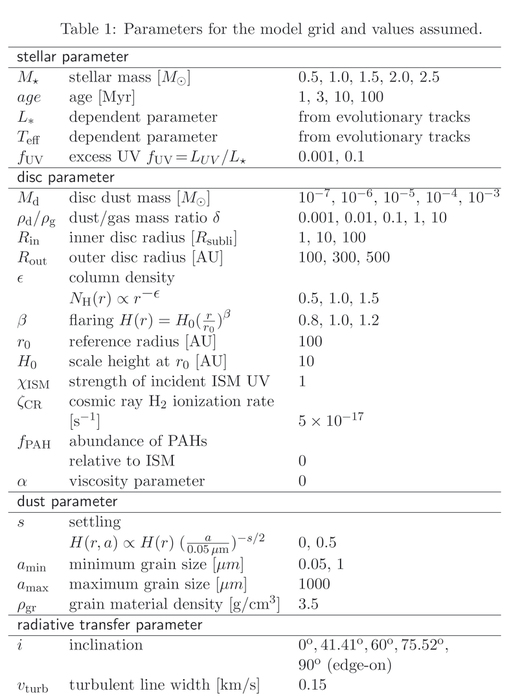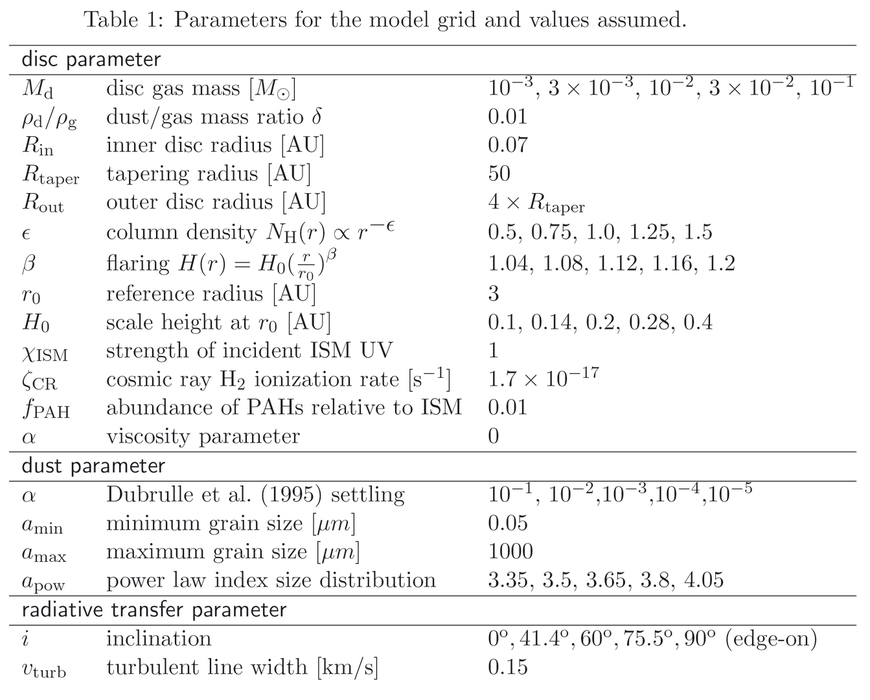Model Grids
The DENT grid
The general outline of our numerical pipeline is described in Woitke et al. (2010) (see their Fig.1). In the first step, MCFOST (Pinte et al. 2006, 2009) is used to compute the dust temperature Tdust(r, z) and frequency dependent radiation field J?(r, z) from radiative transfer. This information is passed on in the second step to ProDiMo (Woitke et al. 2009) to compute the detailed gas chemistry nmol(r, z) and temperature Tgas(r, z). The resulting gas structure together with the non-LTE level population numbers of the relevant species is inserted back into MCFOST to do the line radiative transfer and calculate the line profiles and integrated fluxes (step 3). In a second radiative transfer step, dust spectral energy distributions (SED) are calculated for all models (step 4).
We have chosen 11 free model parameters for the grid, leading to a total of 322 030 disc models. Table 1 summarizes the free parameters in the DENT grid. For completeness, it also contains the fixed parameters r0, H0, χISM, ζCR, fPAH, α, amax, ρgr, and vturb. Effective temperature and luminosity are related parameters and are consistently chosen from the evolutionary tracks of pre-main sequence stars for solar metallicities. Disc models are calculated at four stellar evolutionary times, 1, 3, 10, and 100 Myr. The stellar input spectra are interpolated from Phoenix stellar atmosphere models with solar metallicities.
The grid is very coarse in nature, e.g. stepping through gas mass in factors of ten and thus cannot be used for fitting individual targets. The grid itself has been described in the following papers in much more detail:
Woitke, P., Pinte, C., Tilling, I., Menard, F., Kamp, I., Thi, W.-F., Duchene, G., Augereau, J.-C. 2010, MNRAS 405, L26
Kamp, I., Woitke, P., Pinte, C., Tilling, I., Thi, W.-F., Menard, F., Duchene, G., Augereau, J.-C. 2011, A&A 532, A85
The text and table above is adapted from the appendix of Kamp et al. (2011).
We have chosen 11 free model parameters for the grid, leading to a total of 322 030 disc models. Table 1 summarizes the free parameters in the DENT grid. For completeness, it also contains the fixed parameters r0, H0, χISM, ζCR, fPAH, α, amax, ρgr, and vturb. Effective temperature and luminosity are related parameters and are consistently chosen from the evolutionary tracks of pre-main sequence stars for solar metallicities. Disc models are calculated at four stellar evolutionary times, 1, 3, 10, and 100 Myr. The stellar input spectra are interpolated from Phoenix stellar atmosphere models with solar metallicities.
The grid is very coarse in nature, e.g. stepping through gas mass in factors of ten and thus cannot be used for fitting individual targets. The grid itself has been described in the following papers in much more detail:
Woitke, P., Pinte, C., Tilling, I., Menard, F., Kamp, I., Thi, W.-F., Duchene, G., Augereau, J.-C. 2010, MNRAS 405, L26
Kamp, I., Woitke, P., Pinte, C., Tilling, I., Thi, W.-F., Menard, F., Duchene, G., Augereau, J.-C. 2011, A&A 532, A85
The text and table above is adapted from the appendix of Kamp et al. (2011).
The beta grid
The stellar properties are fixed in this grid: M✶ = 0.7 M☉, age = 1.6 Myr, fUV = 0.01, LX = 1030, Teff = 4000 K, L✶ = 1 L☉. The dust is composed of 45% MgFeSiO4, 35% Mg0.5 Fe0.5 SiO3, 15% amorphous carbon and 5% FeS. The dust temperatures and SEDs are calculated with MCMax (Min et al. 2009) and the gas temperatures, chemical composition and emission lines with ProDiMo (Woitke et al. 2009). There are 1000 models in total and Table 1 shows an overview of the grid.
The main focus is to study the effect of the dust opacity and disc mass & shape parameters. This has been realized in two sets of parameter studies. The first one comprising 625 models varies Mdisk, ϵ, H0, β and keeps fixed α = 10-3, apow = 3.8 and Rout = 200. The second series varies Mdisk over a limited range (3 × 10-3, 10-2 and 3 × 10-2 M☉), α, apow and Rout. This series comprises 225 models and keeps fixed ϵ = 1.0, H0 = 0.2, and β = 1.12.
The grid itself and first results have been described at the workshop “Dust Growth in Star- and Planet-forming Environments” (22-25 July 2013, Heidelberg)
The grid itself and first results have been described at the workshop “Dust Growth in Star- and Planet-forming Environments” (22-25 July 2013, Heidelberg)
woitke_DG13.compressed
PDF-Dokument [3.9 MB]

